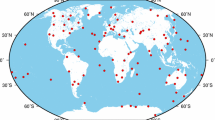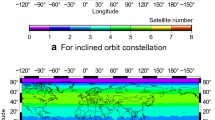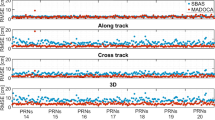Abstract
The fast motion of low earth orbit (LEO) satellite contributes to the geometric diversity, allowing for rapid convergence of precise point positioning (PPP). In this contribution, we investigate the PPP performance of the LEO constellation-augmented full operational capability (FOC) multi-GNSS. We design six LEO constellations with different satellite numbers, orbit altitudes and orbit types, together with the FOC multi-GNSS constellations, and then simulate both the onboard LEO and ground-based observations. The multi-GNSS POD result shows much better orbit accuracy of 3.3, 2.7 and 2.6 cm in radial, along-track and cross-track components, respectively, compared with that of 10.3, 9.2 and 8.9 cm for GPS-only POD. Furthermore, the performance of LEO-augmented multi-GNSS PPP is evaluated. With the augmentation of 60-, 96-, 192- and 288-satellite LEO constellation, the multi-GNSS PPP convergence time can be shortened from 9.6 to 7.0, 3.2, 2.1 and 1.3 min, respectively, in midlatitude region. For LEO-augmented GPS- and BDS-only PPP, the improvement is more significant with the convergence time dramatically shortened by 90% from about 25 to within 3 min with 192- or 288-satellite constellation. The augmentation capability is also found to be associated with station latitude, and the higher latitude, the better performance. To enable about more than 70% significant reduction on convergence time, as well as considering the cost, the 192-satellite LEO constellation scheme is suggested. In terms of orbit altitude, the scheme of 1000 km presents better performance than that of 600 km. As for orbit type, the performances are comparable for polar and sun-synchronous orbits. Additionally, LEO-only PPP can be achieved with the convergence time of about 6.5 min.










Similar content being viewed by others
References
Boehm J, Niell A, Tregoning P, Schuh H (2006) Global mapping function (GMF): a new empirical mapping function based on numerical weather model data. Geophys Res Lett 33(7):L07304
Boehm J, Heinkelmann R, Schuh H (2007) Short note: a global model of pressure and temperature for geodetic applications. J Geod 81(10):679–683
CSNO (2013) BeiDou navigation satellite system signal in space interface control document-open service signal, version 2.0. China Satellite Navigation Office, Dec 2013
DOD SPS, Department of Defense USA (2008) Global positioning system standard positioning service performance standard, 4th edn. http://www.gps.gov/technical/ps/2008-SPS-performancestandard. Accessed 6 Jan 2012
Enge P, Ferrell B, Bennet J, Whelan D, Gutt G, Lawrence D (2012) Orbital diversity for satellite navigation. In: Proceedings of the 25th international technical meeting of the Satellite Division of The Institute of Navigation (ION GNSS 2012), Nashville, TN, pp 3834–3846
Foelsche U, Kirchengast G (2002) A simple “geometric” mapping function for the hydrostatic delay at radio frequencies and assessment of its performance. Geophys Res Lett 29(10):1473
Gao Y (2008) GNSS biases, their effect and calibration. In: Proceedings of IGS workshop, Miami Beach, USA, 2–6 June
GLONASS Interface Control Document ICD (2008) Navigational radiosignal In bands L1, L2, Edition 5.1, Moscow
Guo F, Zhang X, Wang J (2015) Timing group delay and differential code bias corrections for BeiDou positioning. J Geod 89(5):427–445
Inter-Agency Space Debris Coordination Committee (2002) IADC Space Debris Mitigation Guidelines. IADC-02-01
Joerger M, Neale J, Pervan B (2009) Iridium/GPS carrier phase positioning and fault detection over wide areas. In: Proceedings of the 22nd international technical meeting of the Satellite Division of the Institute of Navigation (ION GNSS 2009), Savannah, GA, pp 1371–1385
Ke M, Lv J, Chang J, Dai W, Tong K, Zhu M (2015) Integrating GPS and LEO to accelerate convergence time of precise point positioning. In: Proceeding of the 7th international conference on wireless communications and signal, IEEE, pp 1–5
Kouba J (2009) A guide to using International GNSS Service (IGS) products. http://igscb.jpl.nasa.gov/igscb/resource/pubs/UsingIGSProductsVer21.pdf. Accessed 10 Dec 2017
Li JC, Zhang SJ, Zou XC, Jiang WP (2010) Precise orbit determination for GRACE with zero-difference kinematic method. Chin Sci Bull 55(7):600–606
Li X, Ge M, Dai X, Ren X, Fritsche M, Wickert J, Schuh H (2015a) Accuracy and reliability of multi-GNSS real-time precise positioning: GPS, GLONASS, BeiDou, and Galileo. J Geod 89(6):607–635
Li X, Zhang X, Ren X, Fritsche M, Wickert J, Schuh H (2015b) Precise positioning with current multi-constellation global navigation satellite systems: GPS, GLONASS, Galileo and BeiDou. Sci Rep 5:8328
Li X, Li X, Yuan Y, Zhang K, Zhang X, Wickert J (2018) Multi-GNSS phase delay estimation and PPP ambiguity resolution: GPS, BDS, GLONASS, Galileo. J Geod 92(6):579–608
Liu T, Yuan Y, Zhang B, Wang N, Tan B, Chen Y (2017) Multi-GNSS precise point positioning (MGPPP) using raw observations. J Geod 91(3):253–268
Lou Y, Zheng F, Gu S, Wang C, Guo H, Feng Y (2016) Multi-GNSS precise point positioning with raw single-frequency and dual-frequency measurement models. GPS Solut 20(4):849–862
Montenbruck O, Gill E, Kroes R (2005) Rapid orbit determination of LEO satellites using IGS clock and ephemeris products. GPS Solut 9(3):226–235
OS-SIS-ICD (2010) European GNSS (Galileo) open service signal in space interface control document, SISICD-2006. Eur Space Agency, issue 1:1
Rabinowitz M, Parkinson BW, Cohen CE, O’Connor ML, Lawrence DG (1998) A system using LEO telecommunication satellites for rapid acquisition of integer cycle ambiguities. In: Proceedings of ION/IEEE Position Location and Navigation Symposium, Palm Springs, CA, pp 137–145
Reid TGR, Neish AM, Walter TF, Enge PK (2016) Leveraging commercial broadband LEO constellations for navigation. In: Proceedings of the 29th international technical meeting of the satellite division of the institute of navigation (ION GNSS + 2016), Portland, Oregon, September 2016, pp 2300–2314
Saastamoinen J (1972) Atmospheric correction for the troposphere and stratosphere in radio ranging of satellites. The use of artificial satellites for geodesy. Am Geophys Union Geophys Monogr Ser 15:247–251
Schaer S (2008) Differential code biases (DCB) in GNSS analysis. In: Proceedings of IGS workshop, Miami Beach, USA, 2–6 June
Schaer S (2012) Overview of relevant GNSS biases. In: Proceedings of IGS workshop on GNSS biases. University of Bern, Switzerland, 18–19 Jan
Selding PBD (2015a) SpaceX to build 4000 broadband satellites in Seattle. Space News website. http://spacenews.com/spacex-opening-seattle-plant-to-build-4000-broadband-satellites/. Accessed 19 Jan 2015
Selding PBD (2015b) Virgin, Qualcomm invest in OneWeb satellite Internet venture. Space News website. http://spacenews.com/virgin-qualcomm-invest-in-global-satellite-internet-plan/. Accessed 15 Jan 2015
Selding PBD (2016) Boeing proposes big satellite constellations in V- and C-bands. Space News website. http://spacenews.com/boeing-proposes-big-satellite-constellations-in-v-and-c-bands/. Accessed 23 Jun 2016
Virgili BB, Dolado JC, Lewis HG, Radtke J, Krag H, Revelin B, Cazaux C, Colombo C, Crowther R, Metz M (2016) Risk to space sustainability from large constellations of satellites. Acta Astronaut 126:154–162
Walker JG (1984) Satellite constellations. J Br Interplanet Soc 37:559–572
Yizengaw E, Moldwin MB, Galvan D, Iijima BA, Komjathy A, Mannucci AJ (2008) Global plasmaspheric TEC and its relative contribution to GPS TEC. J Atmos Sol Terr Phys 70(11):1541–1548
Zhong J, Lei J, Dou X, Yue X (2016) Assessment of vertical TEC mapping functions for space-based GNSS observations. GPS Solut 20(3):353–362
Acknowledgements
We are very grateful to the reviewers for their helpful remarks for improving the manuscript. We would also like to express our gratitude to IGS, MGEX, GFZ, DLR and CODE for providing multi-GNSS data and products. This study is financially supported by the National Natural Science Foundation of China (Grant No. 41774030), the Hubei Provincial Natural Science Foundation of China (Grant No. 2018CFA081) and the National Youth Thousand Talents Program.
Author information
Authors and Affiliations
Corresponding author
Rights and permissions
About this article
Cite this article
Li, X., Ma, F., Li, X. et al. LEO constellation-augmented multi-GNSS for rapid PPP convergence. J Geod 93, 749–764 (2019). https://doi.org/10.1007/s00190-018-1195-2
Received:
Accepted:
Published:
Issue Date:
DOI: https://doi.org/10.1007/s00190-018-1195-2




